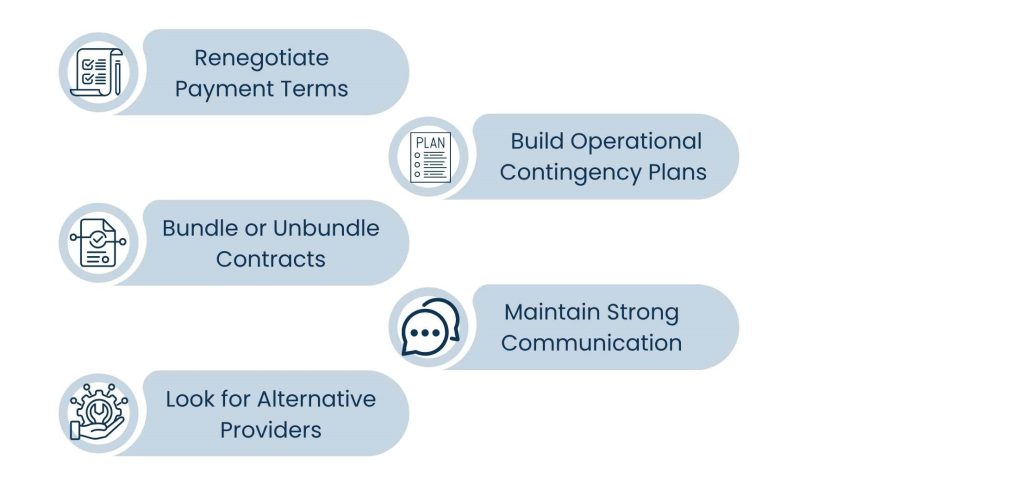Introduction
When a financial setback occurs due to unstable markets or internal miscalculations, it can feel like the business is slipping through your fingers. But let’s face the truth: The setback is not the end. It’s the turning point. This is where business recovery services come into play, offering processes and structure to rebuild operations and restore control, all while putting your business on the track of a wiser way forward.
Recovery isn’t just about reducing costs, nor is it a matter of acting in panic. It’s a process of taking an honest inventory of your financial terrain, making hard but strategic choices, and setting up systems that keep you from repeating them. A strong business recovery plan re-aligns cash flow, processes, and people, and does so without risking future success.
Whether you own a small business or coordinate operations for a midsize company, knowing how the recovery works helps keep you from blindly moving around. From restructuring debt and cutting expenses to renegotiating with vendors and getting teams aligned, recovery is a slow rebuild.
In this blog, we’ll walk through the most effective ways to restore stability using proven business recovery services, so your business doesn’t just bounce back, but builds back stronger.
Why Does a Business Crisis Hit in the First Place?
Crises hardly ever appear out of thin air. Most business shocks come from the build-up of pressure points, some that have been observed, others that haven’t. As important as getting through a crisis is understanding why it happens. It’s what helps you to break the cycle of repeating those same patterns and create a more solid foundation for yourself going forward.

Here are some of the most common reasons businesses get into crisis mode:
1. Poor Cash Flow Management
A business can maybe make its books look good, but then it lacks cash on hand. Late payments, bad invoicing systems, or heavy overhead can quietly suck out metabolism until it reaches a critical mass.
2. Overdependence on One Revenue Stream or Client
If one contract or product line holds the business up, any disruption, cancellation, market shift, or supply issue can cause a collapse.
3. Lack of Operational Visibility
Without real-time insight into key processes or performance metrics, decision-makers often spot issues too late. By then, the damage is already done.
4. Market Shifts or Economic Events
An external shock, whether inflation, policy, or world events, can transform entire industries overnight. Companies that do not have a BCDR in place are at risk.
5. Leadership Blind Spots
At other times, it’s internal: Misguided growth strategies; slow pivots to new opportunities or threats of agility-crushing competition; early warnings ignored and then buried under flags flapping at half-mast. Healthy with Hardship Every well-run business needs regular health checks to avoid getting derailed.
The first step is to comprehend the underlying causes of a crisis, which can then lead to creating an intelligent business recovery plan. Recovery is not just about bouncing back; it’s also about growing into the kind of company that can take a knock and still keep going. Let’s talk once more about what we can do.
Financial Restructuring: Fix the Foundation First
The first step in any effective recovery is to get your financial house in order. If your cash flow is unstable, debts are piling up, or expenses are outpacing revenue, no amount of strategy will stick. Business recovery services often begin with a clear-eyed financial restructuring plan.
This is not just about cutting costs; it’s about understanding where things are working, what demands so many resources that they need some reconfiguring.

Here’s where to focus:
1. Cash Flow Stabilization
Begin with the current inflows and outflows. Where is money leaking? Can you drag out payments a bit, speed up receivables, or renegotiate your short-term credit terms?
2. Debt Restructuring
Many recovery firms can also assist you in negotiating new terms with lenders. That could come in the form of lower interest rates, lengthier repayment calendars, or a partial write-off when things get really bad!
3. Re-forecasting Budgets
Use real-time data—not old projections—to rebuild a lean, realistic budget. Focus only on what’s essential to keep the business moving.
4. Asset Reallocation
Check if there are underutilized resources that can be sold or leased? Every asset should contribute to stability or growth.
Financial restructuring needs time. However, with the right guidance, it helps restore control and build a financial foundation that supports the next phase of your business without wasting time.
Cost Control Without Killing Momentum
Cutting costs is often the go-to move after a financial hit—but how you do it matters just as much as the numbers you slash. Business recovery services focus on smart cost control: reducing waste, not value.
The goal isn’t to freeze all spending. It’s to identify where resources are misaligned, where money isn’t pulling its weight, and how to streamline operations without losing your edge.

Here’s how recovery teams approach it:
1. Audit Operating Expenses
Account for every item: utilities, software, subscriptions and staffing, marketing expenses. What’s essential, negotiable, or has been overlooked?
2. Identify Low-ROI Activities
If a campaign, vendor, or department function isn’t delivering measurable value, freeze it or cut its size. Rely on data, not gut feel, when assessing what stays.
3. Streamline Teams and Roles
Sometimes this involves restructuring teams or moving around responsibilities. The objective isn’t just to downsize by itself – it’s about ensuring you have a role for everyone needed to recover and grow.
4. Outsource Select Functions
Outsourcing non-core functions like admin, bookkeeping, or customer support can reduce overhead without compromising productivity.
5. Control Without Freezing
Avoid halting all innovation or employee development. Cutting smart means keeping momentum in the areas that drive your business forward.
The right business recovery plan balances discipline with potential. It gives you room to breathe financially without slowing down your ability to adapt, create, or compete.
Supplier Renegotiations and Operational Flexibility
Suppliers are a critical part of your operational engine—but during a financial setback, the terms you once agreed on may no longer serve your current reality. That’s why a core part of business recovery services involves stepping back to renegotiate these relationships and add flexibility into your operations. Suppliers generally know that businesses have their ups and downs. Open and honest conversations often yield solutions that can work for everyone.

This is what recovery teams typically aim to do:
1. Renegotiate Payment Terms
Whether that involves deferring payment terms, tweaking order tempo, or moving to monthly billing, with effect from today, the alleviation of cash-flow pressure can be immediate.
2. Bundle or Unbundle Contracts
Review existing agreements. Can the pack of services be unbundled for better cost savings? Or might combining vendors lower costs and simplify management?
3. Look for Alternative Providers
Sometimes, switching to a smaller/more nimble or local supplier may also decrease long shipping times and minimum purchase amounts/ exorbitant fees.
4. Build Operational Contingency Plans
Flexibility isn’t just about suppliers. It is about building workflows that can pivot if resources are constrained. These involve cross-training employees or re-evaluating fulfillment processes.
5. Maintain Strong Communication
Transparent communication forges long-term trust. Staying connected to partners helps save relationships from dissolving and bridges from burning.
This is about regaining control of how your operations work under pressure as part of a business recovery plan. As you transition from inflexible contracts to elastic partnerships, competing is easier than ever when it comes to how quickly your business can respond more effectively and at lower risk.
Reinstating internal faith and alignment in the team
Financial defeats don’t just hurt the balance sheet; they throw off the team. When doubt sets in, morale can lag, communication gets strained, and production dawdles. Which is exactly why a smart business recovery plan needs to be about more than just numbers; it should actively restore that internal faith while repositioning your team on the same, forward-facing track.

Here’s where recovery-focused leadership makes all the difference:
1. Lead with transparency
During difficult periods, silence creates fear while clarity builds trust. Keep your team informed about what’s happening and how they can help. Weekly updates or open Q&A sessions can go a long way.
2. Recenter the mission
People want to know that their work matters, especially when things are unstable. Tie daily tasks back to recovery goals. Help teams see how their roles support the business getting back on its feet. A renewed sense of purpose energizes teams more than pressure ever could.
3. Reprioritize the right work
Everything cannot be done all at once. During recovery, focus is crucial. Celebrate small wins, together with the team, and build momentum. But whether you’re bringing customer service back online or halving delivery times, these successes keep you going.
4. Encourage cross-functional collaboration
Departments don’t have the luxury of isolating themselves as they seek to recover. You’ve got marketing, ops, finance, and the customer support team working together to figure out problems. Common planning meetings and dashboards can achieve all of those people rowing in the same direction.
5. Recognize effort early and often.
Even small wins deserve recognition. Celebrate problem-solving, adaptability, and teamwork. Calling out or acknowledging somebody personally in due course can help further the behaviors you want to encourage.
Who to Choose for Professional Recovery Allies?
Internal efforts aren’t always sufficient for that. You have trimmed expenses, negotiated with suppliers, revisited the budget, and yet still feel like you are doing little more than treading water. This is when expert business recovery services can really help.
Recognizing when to bring outside help is a mark of strength, not weakness. They are disruption navigators – people who know how to spot blind spots and quickly return a business on track from an entirely different perspective.

Here are some indications that it is time to bring in the professionals:
- Cash flow issues aren’t improving despite budget cuts.
- Leadership is overwhelmed and lacks clarity on next steps.
- Operational inefficiencies are compounding losses.
- Debt is growing, and creditor pressure is increasing.
- Internal teams are stretched thin or demoralized.
- You’re seeing repeated short-term fixes with no long-term progress.
Who you might work with:
- Turnaround Consultants: Experts in diagnosing deep business issues and quickly restructuring strategy
- Financial Advisors or Interim CFOs: Help realign cash flow, balance sheets, and debt repayment plans
- Process Auditors: Examine workflows to find bottlenecks, redundancies, or missed savings
- Leadership Coaches or Change Management Experts: Support decision-making, team alignment, and internal culture shifts
Why outsourcing recovery efforts works:
- These partners aren’t emotionally tied to internal politics.
- They bring proven frameworks and benchmarks.
- They move faster than internal trial-and-error.
- Their outside view often surfaces issues that leadership can’t see from inside the business.
Questions to ask before hiring a business recovery firm:
- So, what have you worked with in the past?
- What’s your personalized recovery strategy?
- When do you estimate that we will have stabilized and seen measurable progress?
- Do you provide hands-on help, or is it more guidance?
- How do you make an exit when the business is back on track?
Professional support can unlock solutions that internal teams just don’t have the time, bandwidth, or perspective to discern. Used strategically, recovery partners are both a buoy, helping us merely to stumble through the worst of it, and an engine for something better on the other side.
Conclusion
The best business recovery services aren’t simply about revitalizing a brand from the outside; they aim to make businesses harder through and through. When teams are engaged, informed, and aligned, recovery is swifter, and the business ends up in a stronger position than it was before things went off course.
A financial blow like this can seem insurmountable, but your business doesn’t have to be defined by it. If you make the right moves, get the proper support, and are given a roadmap to recovery, it is possible. That is exactly what business recovery services aim to do: set you on a course toward stabilizing the damage, refocusing your operations, and starting over smarter.
Whether that’s reshaping finances, instituting cost controls, renegotiating supplier contracts, or getting the team cheering again, everything in that recovery puzzle plays its part. But none of that does any good all by itself. A strong business recovery plan connects all these parts, so that people and processes are aligned with strategy to achieve the same thing: sustainable stability.
And of course, setbacks are part of doing business as well, but so is resilience. The strong companies that do emerge are not the ones that have dodged every storm. And they are the only ones who know how to avert it when and if it does hit.
If your company is experiencing financial distress, this isn’t the time to wait. Team up with professional business recovery services for the resources and advice to stay ahead and in control.
About Us
Tasks Expert offers top-tier virtual assistant services from highly skilled professionals based in India. Our VAs handle a wide range of tasks, from part time personal assistant to specialized services like remote it support services, professional bookkeeping service etc. Furthermore, it helps businesses worldwide streamline operations and boost productivity.
Ready to elevate your business? Book a Call and let Tasks Expert take care of the rest.









